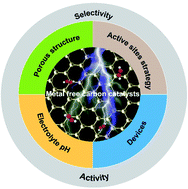A review of advanced metal-free carbon catalysts for oxygen reduction reactions towards the selective generation of hydrogen peroxide
Abstract
Hydrogen peroxide (H2O2) is a versatile and environmentally friendly oxidant with a wide range of industrial and household applications. In recent years, the decentralization of H2O2 production through the two-electron oxygen reduction reaction (ORR) has emerged as an attractive alternative to the well-established anthraquinone process. And of the many electrocatalysts developed for the two-electron ORR to produce H2O2, metal-free carbon catalysts (MFCCs) have received extensive attention due to their cost-effectiveness and natural abundance. Based on this, this review will provide an in-depth overview into MFCC design and fabrication with an emphasis on porosity control, heteroatom doping, oxygen functionalization, defect engineering and organic–inorganic interface engineering. This review will also discuss and analyze the interplays between these factors in terms of MFCC catalytic activity and selectivity towards H2O2 production. Furthermore, major technical challenges are presented, and future research directions are proposed to guide further development towards practical application.



 Please wait while we load your content...
Please wait while we load your content...